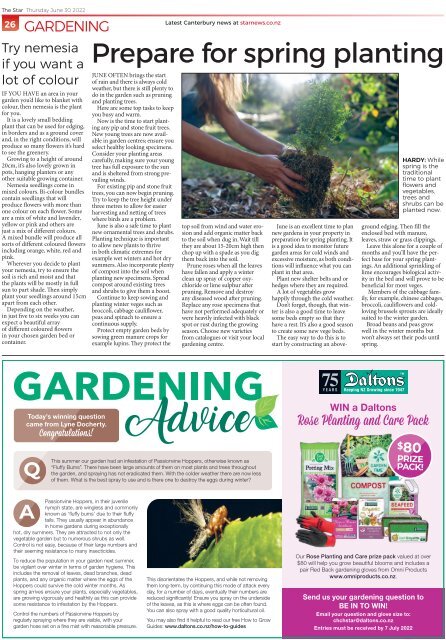The Star: June 30, 2022
You also want an ePaper? Increase the reach of your titles
YUMPU automatically turns print PDFs into web optimized ePapers that Google loves.
<strong>The</strong> <strong>Star</strong> Thursday <strong>June</strong> <strong>30</strong> <strong>2022</strong><br />
26<br />
GARDENING<br />
Try nemesia<br />
if you want a<br />
lot of colour<br />
IF YOU HAVE an area in your<br />
garden you’d like to blanket with<br />
colour, then nemesia is the plant<br />
for you.<br />
It is a lovely small bedding<br />
plant that can be used for edging,<br />
in borders and as a ground cover<br />
and, in the right conditions, will<br />
produce so many flowers it’s hard<br />
to see the greenery.<br />
Growing to a height of around<br />
20cm, it’s also lovely grown in<br />
pots, hanging planters or any<br />
other suitable growing container.<br />
Nemesia seedlings come in<br />
mixed colours. Bi-colour bundles<br />
contain seedlings that will<br />
produce flowers with more than<br />
one colour on each flower. Some<br />
are a mix of white and lavender,<br />
yellow or pink and others are<br />
just a mix of different colours.<br />
A mixed bundle will produce all<br />
sorts of different coloured flowers<br />
including orange, white, red and<br />
pink.<br />
Wherever you decide to plant<br />
your nemesia, try to ensure the<br />
soil is rich and moist and that<br />
the plants will be mostly in full<br />
sun to part shade. <strong>The</strong>n simply<br />
plant your seedlings around 15cm<br />
apart from each other.<br />
Depending on the weather,<br />
in just five to six weeks you can<br />
expect a beautiful array<br />
of different coloured flowers<br />
in your chosen garden bed or<br />
container.<br />
JUNE OFTEN brings the start<br />
of rain and there is always cold<br />
weather, but there is still plenty to<br />
do in the garden such as pruning<br />
and planting trees.<br />
Here are some top tasks to keep<br />
you busy and warm.<br />
Now is the time to start planting<br />
any pip and stone fruit trees.<br />
New young trees are now available<br />
in garden centres; ensure you<br />
select healthy looking specimens.<br />
Consider your planting areas<br />
carefully, making sure your young<br />
tree has full exposure to the sun<br />
and is sheltered from strong prevailing<br />
winds.<br />
For existing pip and stone fruit<br />
trees, you can now begin pruning.<br />
Try to keep the tree height under<br />
three metres to allow for easier<br />
harvesting and netting of trees<br />
where birds are a problem.<br />
<strong>June</strong> is also a safe time to plant<br />
new ornamental trees and shrubs.<br />
Planting technique is important<br />
to allow new plants to thrive<br />
in both climatic extremes for<br />
example wet winters and hot dry<br />
summers. Also incorporate plenty<br />
of compost into the soil when<br />
planting new specimens. Spread<br />
compost around existing trees<br />
and shrubs to give them a boost.<br />
Continue to keep sowing and<br />
planting winter veges such as<br />
broccoli, cabbage cauliflower,<br />
peas and spinach to ensure a<br />
continuous supply.<br />
Protect empty garden beds by<br />
sowing green manure crops for<br />
example lupins. <strong>The</strong>y protect the<br />
Latest Canterbury news at starnews.co.nz<br />
Prepare for spring planting<br />
top soil from wind and water erosion<br />
and add organic matter back<br />
to the soil when dug in. Wait till<br />
they are about 15-20cm high then<br />
chop up with a spade as you dig<br />
them back into the soil.<br />
Prune roses when all the leaves<br />
have fallen and apply a winter<br />
clean up spray of copper oxychloride<br />
or lime sulphur after<br />
pruning. Remove and destroy<br />
any diseased wood after pruning.<br />
Replace any rose specimens that<br />
have not performed adequately or<br />
were heavily infected with black<br />
spot or rust during the growing<br />
season. Choose new varieties<br />
from catalogues or visit your local<br />
gardening centre.<br />
HARDY: While<br />
spring is the<br />
traditional<br />
time to plant<br />
flowers and<br />
vegetables,<br />
trees and<br />
shrubs can be<br />
planted now.<br />
<strong>June</strong> is an excellent time to plan<br />
new gardens in your property in<br />
preparation for spring planting. It<br />
is a good idea to monitor future<br />
garden areas for cold winds and<br />
excessive moisture, as both conditions<br />
will influence what you can<br />
plant in that area.<br />
Plant new shelter belts and or<br />
hedges where they are required.<br />
A lot of vegetables grow<br />
happily through the cold weather.<br />
Don’t forget, though, that winter<br />
is also a good time to leave<br />
some beds empty so that they<br />
have a rest. It’s also a good season<br />
to create some new vege beds.<br />
<strong>The</strong> easy way to do this is to<br />
start by constructing an aboveground<br />
edging. <strong>The</strong>n fill the<br />
enclosed bed with manure,<br />
leaves, straw or grass clippings.<br />
Leave this alone for a couple of<br />
months and you’ll have the perfect<br />
base for your spring plantings.<br />
An additional sprinkling of<br />
lime encourages biological activity<br />
in the bed and will prove to be<br />
beneficial for most veges.<br />
Members of the cabbage family,<br />
for example, chinese cabbages,<br />
broccoli, cauliflowers and coldloving<br />
brussels sprouts are ideally<br />
suited to the winter garden.<br />
Broad beans and peas grow<br />
well in the winter months but<br />
won’t always set their pods until<br />
spring.


















